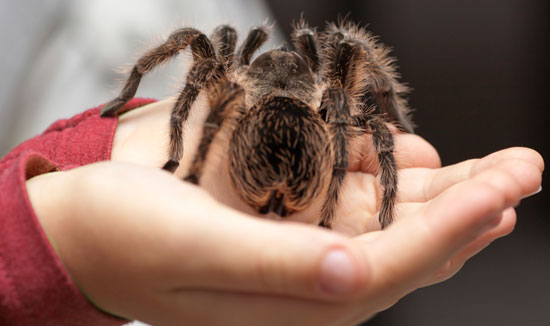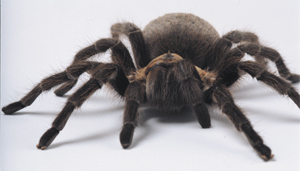How to Keep Spiders as Pets
Spiders can make fascinating pets. Here are a few steps to get you started keeping spiders.

Step 1: Catch a spider
Spiders are all around us, indoors and out, so they’re not hard to find. Some species can bite and a few are venomous. Learn about dangerous spiders in your area before heading out. It’s easy to safely catch a spider by using a small jar. Gently coax it into the jar using the lid. Spiders will eat each other, so keep only one per jar.
Step 2: Prepare a cage
Large spiders do well in the inexpensive plastic terrariums available from pet stores. Smaller ones can be kept in jars or plastic containers if air holes are drilled into the lid or sides. Be sure the holes are small enough to prevent escape.
Potting soil makes good cover for the cage bottom. Sticks, dead leaves or artificial plants provide structure for hiding, climbing and webbing.
Step 3: Water
Depending on the size of the spider, anything from a plastic bottle cap to a small bowl can serve as a water dish. Spiders also drink water sprayed on webbing, but you should never allow the cage to become damp.
Step 4: Feeding
Offer insect prey once or twice a week. Crickets are available from pet shops, or you can collect insects outdoors if no insecticides have been sprayed in the area.
Step 5: Observing
Watch your spider and take notes on its behavior. You won’t believe what happens in the spider’s web until you’ve visited it yourself!
PREFERRED PETS
 Not all spiders do well in captivity. Active hunters are usually easier to keep than web builders. Here are a few that make good pets.
Not all spiders do well in captivity. Active hunters are usually easier to keep than web builders. Here are a few that make good pets.
Tarantulas: Some species exceed 10 inches in legspan. They’re by far the most popular pet spiders and can be bought in pet stores.
Wolf Spiders: Some can be more than three inches in legspan. Large specimens do best in terrariums with lots of floor space.
Jumping Spiders: Although small and rarely exceeding half an inch, their jumping ability is amazing. Many species are brightly colored and can easily be kept in jars.
Fishing Spiders: In captivity, these large spiders appreciate vertically arranged pieces of bark for climbing. They’re very fast, so use caution when capturing them.
Grass Spiders: These spiders build funnel-shaped webs in grass, bushes and on buildings. In captivity, they will build extensive webs inside their cage.
LEARN MORE: Click here to see photos of a spider expert’s seven favorite spiders
i officialy love spiders after readin all ur comments….gonna get a trantula now 🙂
i found a house spider in my house and its kinda long but I dont know what to put in its cage, grass, wood chips, what do i put in it?
i dont know if i have a jumping spider or a wolf spider or a house spider i just dont know what should i do with it
Woodchips
i found a little brown spider in our sandbox in our backyard. does anybody know what kind it is??? i put it in a jar with a some potting soil, but i dnt know if it likes it he just stays on the side of the jar and kinda balls up.
its probaly dieing……….im not sure if your suppose to use soil as subtrate
the brown spider i have seen it on tv it is deadly do not touch it ok
my jumping spider spun its web beside the jar lid, now i cant feed it, what should i do?
use a needle to get rid of the web.
if your spider is not spinning a web that is fine because some spiders hunt by themselves without a web
Does a baby tarantula which is about an inch or less eat jumping spiders? I’m afraid it might turn to the other way around and my tarantula ends up being the one that dies… What can I feed it with, something that has can be found at home with garden. (no cricket, no cockroach, no grasshopper…)
give the sling a pin head cricket, no danger there. find them at your local pet store.
you should go to a pet store
I just caught a brown recluse spider in my backyard. Is it alright to keep it?
no,definently not,Sandy they are very poisonous . they could kill you.
No its deadly
I don’t like spiders, but I have heard that a preying mantis makes a good pet too.
But they can hurt hummingbirds
I found a spider in my living room. I’m not quite sure what it is. It looks like a jumping spider. I would say it’s about 1/4 to 1/3 of an inch. I’m not sure whether to keep it until it gets warmer outside or let it go in the cold or let it go on a plant in my house. What should I do?
letting it outside in the cold is the best Idea, but don’t be worried about it dying in the cold cause most spiders that have that over a year to live will hibernate.